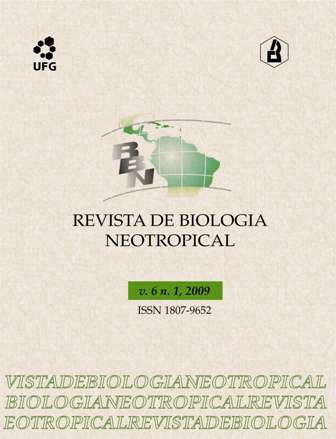Populational structure of Macrobrachium brasiliense (Crustacea, Palaemonidae) of the Escondido Stream, Batayporã, Mato Grosso do Sul, Brazil
DOI:
https://doi.org/10.5216/rbn.v6i1.12630Keywords:
Population biology, freshwater prawn, decapodaAbstract
This study was carried out to examine Macrobrachium brasiliense (Heller, 1862) population biology with emphasis on abundance, frequency distribution, sexual proportion and recruitment of this species in the Escondido stream (Batayporã, Mato Grosso do Sul, Brazil). Shrimp were monthly collected during one year, from January 2006 to December 2006, in three predetermined points, according to diversity of habitats. The capture effort was performed by two people for 30 minutes in each point and a total of 911 shrimp were collected. The sex of the collected individuals was determined based on the presence of the masculine appendix, and the total length and the carapace length were measured for each animal. The greatest reproductive activity of this species probably occurs in the spring and the beginning of the recruitment, in the summer. No significant difference was observed between sexes and the sexual proportion found was 1:1,1.Downloads
References
Ayres, M., M. Ayres Júnior, D. L. Ayres & A. A. Santos. 2007. BioEstat: aplicações estatísticas nas áreas das ciências biomédicas. Sociedade Civil Mamirauá, Belém, v. 5, 324 p.
Borges, M. S. 2003. Distribuição, abundância e biologia reprodutiva de Macrobrachium amazonicum (Heller, 1862) e Macrobrachium jelskii (Miers, 1877) (Crustacea, Decapoda, Palaemonidae) no Açude Público de Rômulo Campos, Itiúba – Bahia. Trabalho de conclusão de curso, Universidade Federal da Bahia, Salvador.
Coelho, P. A. & M. Ramos-Porto. 1985. Camarões de água doce do Brasil: Distribuição geográfica. Rev. Bras. Zool. 2: 405-410.
García-Dávila, C. R. 1998. Revisão taxonômica dos camarões de água doce (Crustacea: Decapoda: Palaemonidae, Sergestidae) da Amazônia Peruana. Dissertação de Mestrado. Instituto Nacional de Pesquisas de Amazônia/Fundação Universidade do Amazonas, Manaus.
García-Dávila, C. R., F. B. Alcántara, E. R. Vasquez & M. Chujandamas. 2000. Biologia Reprodutiva do camarão Macrobrachium brasiliense (Heller, 1862) (Crustacea: Decapoda: Palaemonidae) em Igarapés de Terra Firme da Amazônia Peruana. Acta Amazonica 30: 653-664.
Hartnoll, R. G. 1982. Growth, p. 111-196. In: L. G. Abele (Ed.), The biology of Crustacea. New York, Academic Press, v. 2.
Hendrickx, M. E. 1995. Checklist of Brachyuran crabs (Crustacea: Decapoda) from the eastern tropical Pacific. Biologie 65: 125-150.
Holthuis, L. B. 1952. A general revision of the Palaemonidae (Crustacea, Decapoda, Natandia) of the Americas. II. The subfamily Palaemonidae. Occas. Pap. A.H.F.P. 12: 1-79.
Kensley, B. & I. Walker. 1982. Palaemonid shrimps from the Amazon Basin, Brazil (Crustacea: Decapoda: Natantia). Smithson. Contrib. Zool. 362: 1-18.
Magalhães, C. & I. Walker. 1988. Larval development and ecological distribution of central Amazonian palaemonid shrimps (Decapoda: Caridea). Crustaceana 55: 279-292.
Mantelatto, F. L. M. & L. R. Barbosa. 2005. Population structure and relative growth of freshwater prawn Macrobrachium brasiliense (Decapoda, Palaemonidae) from São Paulo State, Brazil. Acta Limnol. Brasil. 17: 245-255.
Mattos, L. A. & L. M. Y. Oshiro. 2009. Estrutura populacional de Macrobrachium potiuna (Crustacea, Palaemonidae) no Rio do Moinho, Mangaratiba, Rio de Janeiro, Brasil. Biota Neotrop. 9: 81-86.
Melo, G. A. S. 2003. Manual de identificação dos Crustacea Decapoda de água doce do Brasil. Loyola, São Paulo, 420 p.
Montoya, J. V. 2003. Freshwater shrimps of the Genus Macrobrachium associated with roots of Eichhornia crassipes (Water Hyacinth) in the Orinoco Delta (Venezuela). Caribb. J. Sci. 39: 155-159.
Nagamine, C. M. & A. W. Knight. 1980. Development, maturation and function of some sexually dimorphic structures of the Malaysian prawn Macrobrachium rosenbergii (De Man) (Decapoda, Palaemonidae). Crustaceana 39: 141-152.
Odinetz Collar, O. & A. Enriconi. 1993. Estratégia reprodutiva e alguns aspectos demográficos do camarão Palaemonetes carteri Gordon, 1935 na Amazônia Central, Rio Negro. Acta Amazon. 23: 227-243.
Silva, M. C. N., F. L. Frédou & J. S. R. Filho. 2007. Estudo do crescimento do camarão Macrobrachium amazonicum (Heller, 1862) da ilha de Combú, Belém, Estado do Pará. Amazônia: Ciên. Desenv. 2: 85-104.
Sokal, R. R. & F. J. Rohlf. 1995. Biometry. The principles of practices of statistics in biological research. 3rd ed, New York, 887 p.
Valenti, W. C. 1998. Carcinicultura de água doce: tecnologia para a produção de camarões. IBAMA/FAPESP, Brasília, DF, 383 p.
Valenti, W. C., J. T. C. Mello & V. L. Lobão. 1987. Crescimento de Macrobrachium acanthurus (Wilegmann, 1836) do Rio Ribeira de Iguape (Crustacea, Decapoda, Palaemonidae). Rev. Bras. Biol. 47: 349-335.
Downloads
Published
How to Cite
Issue
Section
License
The expontaneos submmition of the manuscript automaticaly implies in the cession of all patrimonial rights for the Journal of Neotropical Bilogy (RBN) after publication. The autor allow the right of first publication of the article to the RBN, under Creative Commons Attribution 4.0 (CC BY-NC 4.0) Licence.
There are garanties for the authors to the authorial and moral rights, for each one of the articles published by RBN, with permissions:
1. The use of article and contents for the education and researches.
2. The use of the article and their contents, linking to the Article on the web site of the RBN, allowing the divulgation on:
- institutional closed web (intranet).
- open access repositories.
3. Preparation and divulgation of the other publication derived from the article and its content, if there is citation of the original publication by RBN.
4. Make printed copies in small quatinties for personal use.

















